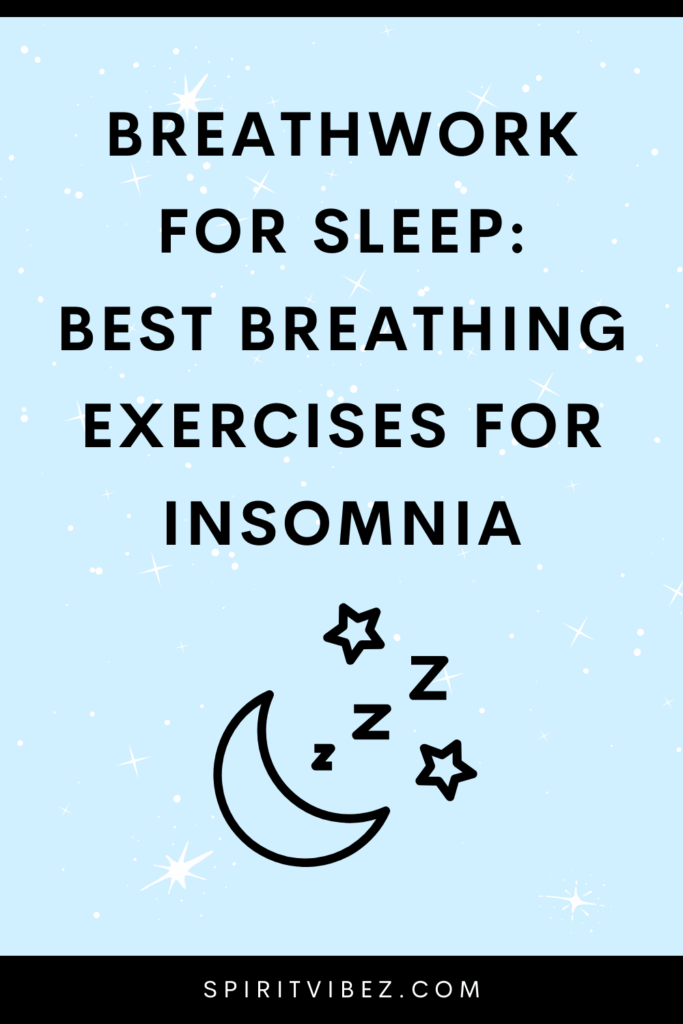Last Updated on May 22, 2025

If you struggle to fall asleep at night, you’re not alone.
Insomnia, anxiety, and racing thoughts can keep your nervous system on high alert—long after your body craves rest.
The good news? You can use breathwork for sleep to signal safety to your body and gently drift into deep rest.
Breathwork is a powerful yet simple tool to support the mind and body.
From ancient yogic techniques to modern military sleep strategies, there’s a growing body of science and tradition proving that breathing for deep sleep really works.
In this article, we’ll explore the best breathwork for sleep, including exercises that calm anxiety and promote deep relaxation.
See also:
What is breathwork and why use it for sleep?
Breathwork refers to intentional breathing techniques that help regulate your nervous system, reduce stress, and improve mental clarity.
Practicing breathwork for sleep and anxiety allows your body to shift from a stressed, alert state into a calm, parasympathetic mode—the state needed for deep, restorative rest.
Some key breathwork for sleep benefits include:
- Reduced anxiety and racing thoughts
- Lower heart rate and blood pressure
- Increased melatonin production
- Improved sleep quality and duration
- Relaxation of the muscles and nervous system
It’s not just woo-woo wellness—it’s backed by research.
Breathing affects your vagus nerve, heart rate variability, and even brain waves, helping you transition into deep rest more efficiently.
Best breathwork for sleep
Below, you’ll find 4 powerful breathwork techniques that can help you relax your mind, release tension from your body, and ease into a peaceful night’s sleep.
1. The 4-7-8 breathing technique
Also known as the “breathing exercise to fall asleep in 60 seconds,” this simple yet powerful practice slows your heart rate and quiets the mind.
How to practice:
- Inhale quietly through your nose for 4 seconds
- Hold your breath for 7 seconds
- Exhale slowly through your mouth for 8 seconds
- Repeat for 4 cycles
Many people report feeling drowsy after just a few rounds. It’s one of the best breathwork for sleep options, especially if your mind is racing.
2. Box breathing (Military breathing technique for sleep)
Used by Navy SEALs to stay calm under pressure, box breathing is a great breathing sleep technique for grounding and focus.
How to practice:
- Inhale for 4 seconds
- Hold for 4 seconds
- Exhale for 4 seconds
- Hold for 4 seconds
This technique is also beneficial if you suffer from nighttime anxiety or wake up in the middle of the night.
3. Alternate nostril breathing (Nadi Shodhana)
A traditional yogic breath that balances the left and right sides of the brain, promoting calm and clarity.
How to practice:
- Use your right thumb to close your right nostril
- Inhale through your left nostril
- Close the left nostril with your ring finger and release the right
- Exhale through the right nostril
- Inhale through the right, then switch again
- Continue for 5–10 rounds
This is a great breathwork for deep sleep practice before bed or during evening meditation.
4. Coherent breathing (For deep calm and nervous system reset)
Coherent breathing is a slow, steady breath pattern that helps calm the mind and body by regulating your heart rate and nervous system.
How to practice:
- Inhale gently through your nose for 5 seconds
- Exhale slowly through your mouth or nose for 5 seconds
- Continue this balanced rhythm for 5–10 minutes
This type of breathwork for deep sleep can be done lying in bed or while sitting quietly in a dim room.
Many people find that this technique helps them release tension and fall asleep more peacefully.
Bonus: breathwork for sleep video
If you’re a visual learner or prefer guided support, look for a breathwork for sleep video on YouTube or wellness platforms.
Many videos include calming visuals, binaural beats, and voice guidance to help you fully relax into the experience.
Try these:
- Guided breathwork for sleep 15 minutes
- Military breathing technique for sleep
- Breathwork for deep sleep
How to practice breathwork every night
To make breathing for better sleep a consistent habit:
- Set aside 5–10 minutes before bed
- Dim the lights and reduce screen time
- Practice your chosen technique lying in bed or sitting upright
- Use essential oils (like lavender or chamomile) to deepen the effect
- Stick with it—even 2 minutes of nightly practice can reset your sleep patterns over time
Final thoughts
In a world full of distractions, breathwork for sleep is one of the most accessible and effective tools to reclaim your rest.
Whether you’re dealing with anxiety, insomnia, or sleep apnea, your breath holds the key to better nights and brighter mornings.
So tonight, instead of scrolling or tossing and turning, try one of these breathing sleep techniques.
Inhale, exhale—and let your breath guide you home to rest.
If you enjoyed this article about breathwork for sleep, I would be grateful if you shared it on Twitter, Facebook, or Pinterest! Thank you❤️
📌 PIN THIS POST FOR LATER


Hello, my name is Sara and I am the founder of Spiritvibez, I’m here to guide you on your spiritual journey toward healing, growth, and self-discovery. I believe that true transformation occurs when the mind, body, and spirit are aligned and working in harmony. Through Spiritvibez, I hope to inspire and empower you to deepen your spiritual practice, embrace your authentic self, and begin living your best life.
